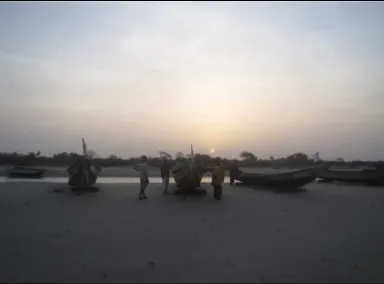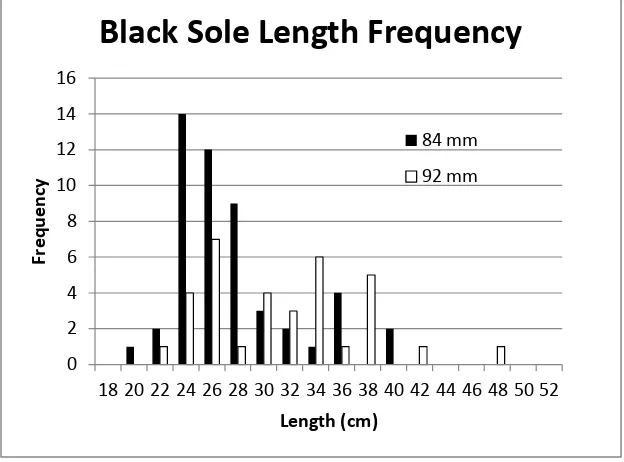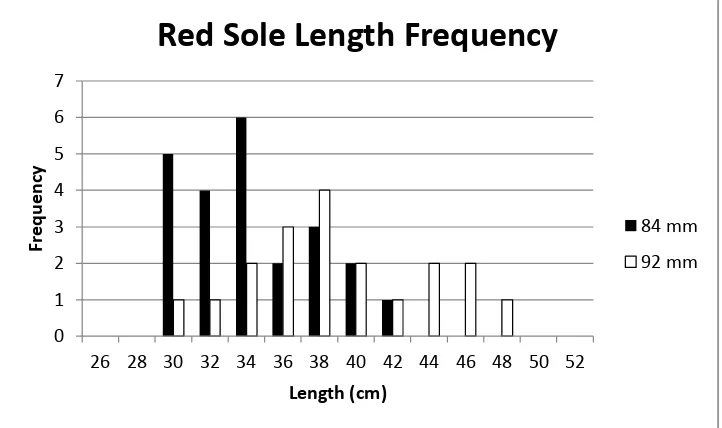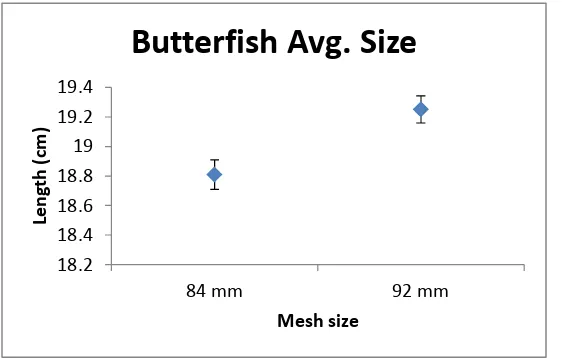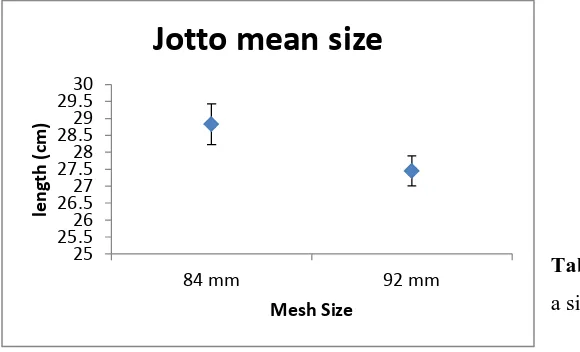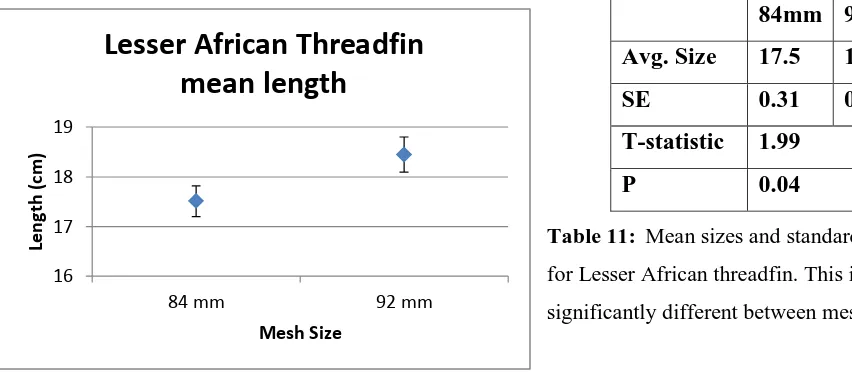Catch comparison of two mesh sizes in the bottom
gillnet used in the Gambian sole fishery
November 2013
2
The work herein was supported by the USAID funded Gambia-Senegal Sustainable Fisheries Project (BaNafaa). The BaNafaa project is implemented by the Coastal Resources Center at the University of Rhode Island and the World Wide Fund for Nature-West Africa Marine Program Office (WWF-WAMPO) in partnership with the Department of Fisheries and the Ministry of Fisheries and Water Resources. Data collected and prepared by Gibril Gabis,
Geoffrey Kibler from the USAID/BaNafaa Project and Kathleen Castro and Chris Parkins from the University of Rhode Island.
Disclaimer: This report was made possible by the generous support of the American people
through the United States Agency for International Development (USAID). The contents are the responsibility of the authors and do not necessarily reflect the views of USAID or the United States Government. Cooperative Agreement # 624-A-00-09- 00033-00.
Citation: Gabis, G., Kibler, G., Castro, K and C. Parkins.2013. Catch comparison of two mesh
sizes in the bottom gillnet used in the Gambian sole fishery. 2013 pp 18
Cover Photo: Geoffrey Kibler Peace Corps Volunteer, USAID/BaNafaa project/World Wide
Fund for Nature-West Africa Marine Program Office (WWF-WAMPO).
Photo Credit: Geoffrey Kibler Peace Corps Volunteer, USAID/BaNafaa
project/WWF-WAMPO
Acknowledgements: We wish to thank the local fishermen of Kartong, Saikou Njie and
3
Contents
Introduction ... 4
Objective ... 5
Description of Fishing Area ... 6
Materials and Methods ... 7
Figure 2: Sole fisheries hotspot mapping 6
Figure 3: Photo of plank dugout canoes, Kartong Fisherman and the Kartong Landing Sites 7
Figure 4: Black Sole mean size with standard error. 10
Figure 5: Length frequency of black sole from the two mesh sizes. 10
Figure 6: Mean size of red sole captured by mesh size (with standard error). 11 Figure 7: Length frequency of red sole caught with the two mesh size 11
Figure 8: Catfish mean size with standard error bars 12
Figure 9: Length frequency of catfish captured in the two mesh sizes. 12 Figure 10: Sompat grunt mean size with standard error bars. 13
Figure 11: Butterfish mean size with standard error bars. 13 Figure 12: Sardinella mean size with standard error bars. 14
Figure 13: Bigeye grunt mean size with standard error bars. 14 Figure 14: Mean size plus standard error for Cassava croaker. 15
4
List of Tables
Table 1: List of species and total number of individuals captured by mesh size... 9
Table 2: Black sole mean size and standard error (SE). ... 10
Table 3: Red sole mean size and ... 11
Table 4: Mean catfish size ... 12
Table 5: Sompat grunt mean size with standard error. ... 12
Table 6: Butterfish mean size and ... 13
Table 7: Average sardinella size ... 14
Table 8: Bigeye mean size and standard error. ... 14
Table 9: Mean size of Cassava ... 15
Table 10: Jotta mean size... 15
5
Introduction
The Fishery Co-Management Plan for the Gambian Sole Complex, the first such plan in the Gambia, was formally adopted in January 2012. The precautionary approach is part of the basic framework for the plan, especially important in fisheries with limited data. Most of the data for the management actions in the plan came from local knowledge and limited data collection by the USAID/BaNafaa project, the National Sole Co-management Committee (NASCOM) and the Gambian Department of Fisheries (DOFISH). The committee included a closed area from shore out to 1 nm annually from May to October to protect fish during spawning periods as a
precautionary measure even though the first stock assessment did not find evidence of overfishing.
One of the research priorities identified in the plan included work on improving gillnet
selectivity, especially for the bycatch species of catfish that is listed as vulnerable. A previous study conducted on hanging ratio determined some improvement to selection was possible, however the added work of attaching the net to the hanging lines, difficulty of enforcement and the loss of fish makes this feature unattractive as a management measure. Therefore, the
committee opted to examine the increase of mesh size as a possible management option. This study is designed to test the change in catch between the standard net currently used (84 mm stretched mesh) in the fishery to a larger mesh size (92 mm stretched mesh). Note: Legal minimum mesh size is 80 mm stretched mesh although fishermen are already using larger mesh sizes.
Objective
6
Description of Fishing Area
The fishing trials were conducted in a 5 nautical mile radius off the coast of Kartong on the Atlantic
coast of The Gambia (13°05ˈ26.01 “N and
16°45ˈ15.76” (Figure 1)). This area is characterized by exposed coastal beaches composed of mostly sandy bottom with some rocky reef areas. The village of Kartong is located at the mouth of the
Allehien river estuary (Figure 2). Figure 1: The Gambia
Locally know to be a hotspot for the Sole fishery and other locally important fish species.
Kartong is known as a sole hot spot by local fishermen. Fishing areas are indicated by yellow dots on the GIS figure. Fishing trials were conducted from May 25-June 22, 2013 resulting in 29 net hauls.
7
Materials and Methods
A planked dug-out (motorized) canoe (11m) propelled by 25HP (Yamaha) was used for the study (Figure 3). Four crew were involved in the study (2 local fishers and 2 from the USAID/Ba Nafaa team.
Figure 3: Photo of plank dugout canoes, Kartong
Fisherman and the Kartong Landing Sites
Two monofilament nets were prepared for the study and fished side by side. The first net was constructed with 84 mm mesh while the second was 92 mm. Both nets were 720 m in length. The Gambians designate mesh size by bar length (which is ½ stretched mesh size). No hanging ratio was used in either gillnet.
Data on species, length, weight, gear type and mesh size were recorded. Both nets were hauled every 24hrs. Different fishing grounds were used during the study and the GPS coordinates were recorded. An electronic scale was used for weighing and a measuring board with 1 mm
increments was used for measuring length. A handheld Garmin GPS was used for the recording of coordinates. Fish were identified using the fish guide to the identification of saltwater
Senegalese and Gambian fish (Bellemans et al, 1988) and the Gambian fish guide (Gabis et al, 2012).
Results
8
Gainde gauge 26 19 Gainde gauge/Milk shark
Lutjanus agennes 4 6 Yahk/red snapper
Caranx crysos 13 3 Fetta/Blue runner
Pentanemus quinquarius 36 19 Ngorr sikem/Royal threadfin
Dentex angolensis 311 295 Camera camera Butterfish
Brachydeuterus auritus 141 173 Hurr hurr/bigeye grunt
Pomadasys jubelini 60 125 Sompat/Sompat grunt
Pseudotolithus elongates 75 64 Jotto/Bobo croaker
Cynoglossus senegalensis 23 19 Red sole
Synaptura cadenati 50 34 Black sole
Pseudotolithus senegalensis 78 69 Fotta/Cassava croaker
Galeoides decadactylus 45 38 Chekem/Lesser African threadfin
Chloroscombrus chrysurus 81 34 Lanya lanya/Atlantic bumper
Pseudotolithus brachygnathus 16 19 Nguka/Law croaker
Polydactylus quadrifilus 3 1 Kujali/Giant Africa threadfish
Epinephelus aeneus 5 0 Choff/ White grouper
Acanthurus monroviae 4 19 Doctour gauge/Doctor fish
Plectorhynchus mediterraneous 3 23 Wasampierre/Rubberlip grunt
Sparus aurata 0 1 Warrange/Gilthead seabream
Alectis alexandrines 0 7 Yawal/Pompano
Pseudotolithus typus 18 9 Tonone/ladyfish
Sphyrna spp 18 15 Hammerhead shark
Drepane Africana 16 63 Tapendar/African sicklefish
Ephippion guttifer 10 13 Konkareh/Puffer
Sardinella maderensis 259 340 Yoboye Tass/Madeiran sardinella
9
Ethmalosa fimbriata 45 36 Bonga/shad
Mugil curema 4 0 Tambajang/guiss/Curema mullet
Sardinella aurita 8 4 Yabauye morro/Round sardine
Pomadasys incisus 1 0 Daha/bastard grunt
cuttlefish 1 0 cuttlefish
Scomberomorus tritor 0 2 Njuna/Spanish mackerel
Simput 0 1 Simput
Elaops lacerta 2 0 Lak/west African ladyfish
Umbeina canariensis 5 1 Nyaw neh/Canary drum
Decapterus rhonchus 1 0 Jai/False scad
Not identified 0 2 Torpedo Ray
Caranx hippos 0 1 Saka/Crevelle jack
Total 2166 2200
Table 1: List of species and total number of individuals captured by mesh size.
10
Table 2: Black sole mean size and standard error (SE).
T-test results indicate significant difference
Figure 4: Black Sole mean size with standard error.
Figure 4 and Table 2 shows the average Black sole caught in the 84mm and 92mm mesh nets. The 84mm net caught an average fish size of 27.14 mm and the 92mm caught an average fish size of 30.79 mm. Figure 5 illustrates the shift to larger fish with the bigger mesh size.
Figure 5: Length frequency of black sole from the two mesh sizes.
84mm 92mm Avg. Size 27.14 30.79
SE 0.61 1.01
T-test statistic 3.27
P 0.001
Figure 5. Length frequency of the black sole captured 20
Black sole mean size
0
Black Sole Length Frequency
84 mm
11
Table 3: Red sole mean size and standard error (SE). T-test results indicate significant difference.
Figure 6: Mean size of red sole captured by mesh size (with standard error).
Figure 6 and Table 3 shows the average Red sole caught in the 84mm and 92mm mesh nets. The 84mm net caught an average fish size of 33.87 mm and the 92 caught an average fish size of 38.42 mm. Figure 7 illustrates the shift in range of sizes caught in the larger mesh size.
Figure 7: Length frequency of red sole caught with the two mesh size
84mm 92mm
Avg. Size 33.87 38.42
SE 0.76 1.12
T-statistic 3.45
P 0.001
Red Sole mean length
0
Red Sole Length Frequency
84 mm
12
Table 4: Mean catfish size captured by mesh size.
There was a significant difference.
Figure 8: Catfish mean size with standard error bars
Figure 8 and Table 4 shows the average Catfish caught in the 84mm and 92mm mesh nets. The 84mm net caught an average fish size of 30.76 mm and the 92 caught an average fish size of 33.70. Figure 9 illustrates the shift in range of size of fish captured
Table 5: Sompat grunt mean size with standard error. T-test results indicate significant difference.
Figure 9: Length frequency of catfish captured in the two mesh sizes.
84mm 92mm Avg. Size 30.76 33.70
SE 0.21 0.25
T-test statistic 8.9
P 0.0001
84mm 92mm Avg. Length 25.28 31.95
SE 0.64 0.55
T-statistic 7.29
P 0.0001
Catfish mean length
0
Catfish length frequency
84 mm
13
Figure 10: Sompat grunt mean size with standard error bars.
Figure 10 and Table 5 shows the average Sompat grunt caught in the 84mm and 92mm mesh nets. The 84mm net caught an average fish size of 25.28 mm and the 92 caught an average fish size of 31.95 mm.
Table 6: Butterfish mean size and standard error. T-test results indicate significant difference.
Figure 11: Butterfish mean size with standard error bars.
Figures 11 and Table 6 shows the average Butterfish caught in the 84mm and 92mm mesh nets. The 84mm net caught an average fish size of 18.81mm and the 92 caught an average fish size of 19.25 mm.
Sompat mean length
84mm 92mm Avg. Size 18.81 19.25
SE 0.099 0.093
T-statistic 3.22
14
Table 7: Average sardinella size for each mesh size. There was no significant difference found.
Figure 12: Sardinella mean size with standard error bars.
Figure 12 and Table 7 shows the average Sardinella caught in the 84mm and 92mm mesh nets. The 84mm net caught an average fish size of 21.28 mm and the 92 caught an average fish size of 21.58 mm.
Table 8: Bigeye mean size and standard error. T-test results indicate significant differences between mesh sizes.
Figure 13: Bigeye grunt mean size with standard error bars.
84mm 92mm Avg. Size 21.28 21.58
SE 0.010 0.073
T-statistic 1.65
P 0.09
84mm 92mm Avg. Size 15.68 16.30
SE 0.22 0.18
T-statistic 3.59
P 0.0003
Sardinella mean size
14.5
15
Cassava croaker mean
length
Jotto mean size
Table 9: Mean size of Cassava croaker for each mesh size. There was no significant difference
Figure 14: Mean size plus standard error for Cassava croaker.
Table 10: Jotta mean size. There was not a significant difference.
Figure 15: Mean sizes for Jotto African threadfin with standard error bars.
84mm 92mm Avg. Size 30.9 30.08
SE 0.93 1.00
T-statistic 0.58
P 0.55
84mm 92mm Avg. Size 28.83 27.45
SE 0.60 0.44
t-statistic 1.86
16
Lesser African Threadfin
mean length
Table 11: Mean sizes and standard errors for Lesser African threadfin. This is significantly different between mesh sizes.
Figure 16: Mean sizes for Lesser African threadfin with standard error bars.
Figures 13, 14, 15 and 16 and Tables 8, 9, 10 and 11 summarize the mean sizes and statistics for Bigeye grunt, Cassava croaker, Lesser African threadfin and Bobo croaker. Only the bigeye grunt and Lesser African threadfin show a significant larger size with the bigger mesh.
84mm 92mm Avg. Size 17.5 18.4
SE 0.31 0.36
T-statistic 1.99
17
Discussion
The overall results of the catch comparison of the 84 mm and 92mm bottom gillnet used in the study indicate that significantly larger sole, catfish, Sompat grunt, Bigeye grunt, Lesser African threadfin and butterfish are caught with the larger 92 mm stretch mesh net than in the 84 mm net. Both nets caught most of the same species and the total number captured was not considerably different between the two nets. The increased mesh size has the potential to be a meaningful management tool for the sole and catfish fisheries while also improving the status of grunt and butterfish. The species that did not show a change were sardinella, Cassava croaker and Bobo croaker. Others were not caught in sufficient numbers to compare statistically. Actual selectivity curves were not determined for the gillnets in this study (Holst et al., 1994).
Current mandated minimum mesh and fish size have been arbitrarily determined. New (although not complete) information on sole maturity can now be matched with mean size of fish captured using different mesh sizes. With better biological information, it will greatly improve harvesting rules and fishery sustainability. Preliminary data indicate that 50% maturity of Arius spp occurs between 20-25 cm lengths. Increasing mesh size to 84 or 90 mm will shift the mean size of fish captured to between 31-34 cm, well above the 50% maturity size.
18
References
Bellemans, M., Sagna, A., Fischer, W. and N. Saalabba. 1988. Fiches FAO d’identification des species pour les besoins de la peche. Guide de Ressources Halieutiques du Senegal et de la Gambie. Rome, FAO, 227 pps.
Gabis, G., Parkins, C., and K. Castro. 2011. Characterization of the gillnet fishery in The Gambia. CRC publication, University of Rhode Island 13 pps.
Gabis, G., Drammeh, O., Nichols, E., Kelpsaite, L., Castro, K., Parkins, C., Mendy, A., Ceesay, S., and F. Joof. 2012. Bycatch Assessment in the Gambian Sole Gillnet Fishery. CRC
publication, University of Rhode Island. 18 pps.
Gabis, G., Nichols, E., Kelpsaite, E., Parkins,C., Castro,K. and B. Somers, 2012. Guide for the Identification of Commonly Caught Fish in the Bottom Set Gillnet Fishery in the Gambia, Coastal Resources Center, University of Rhode Island, pp.68
